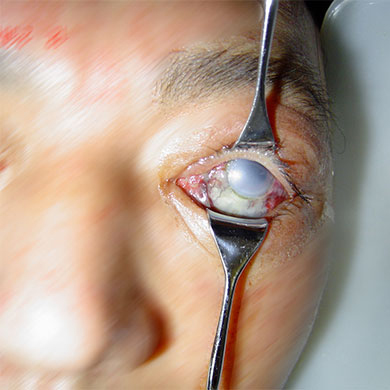Chemical lesions
Mechanism of the chemical burn and creation of the chemical injury
The specificity of chemical injuries (commonly called chemical burns) is the partial or complete destruction of the molecules, the cells or the structure of the skin or the eye induced by either an irritant or a corrosive chemical product. The injury degree is determined by the subsequent modification of the tissues.


A chemical lesion is the local result of the reaction of corrosive or irritant chemical products that react with biological tissues.
The chemical lesion is characterised by partial or total destruction of the biological tissues.
The chemical product reacts with a chemical component of the tissue (a molecule, a cell or a protein…). This reaction destroys the tissue’s biological equilibrium. Modification of the tissue subsequently causes the macroscopic lesion observed. The severity of the lesion is proportional to the amount of tissue destruction: the severity of the chemical lesion is basically related to the type of product, the nature of the tissue involved and the area affected.
The skin, eye and digestive or respiratory tracts are in direct contact with the outside of the body and are therefore the primary targets of chemical products. Chemical lesions designate injuries inflicted by contact between chemical products and these specific tissues.
The chemical lesion may also be accompanied by other systemic symptoms.
When the chemical product causing the chemical lesion is toxic or harmful and passes into the body, reaching the organs or the bloodstream, it may interact with other biological targets.
Benzene for instance is irritant to the skin and eyes. It is a carcinogenic and mutagenic product: it may thus become interposed in the DNA chains and disrupt cell division. It may also lead to cell destruction (aplasia) or proliferation of the cells in haematogenous bone marrow (the organ producing the precursors of the blood cells). This may cause leukaemia.
The chemical products that may cause a chemical lesion are categorised according to the seriousness of the lesions that they may induce: they are corrosive or irritant.
A chemical product is classified among corrosive or irritant agents when it is capable of reacting with biochemical components of the cells and the tissues of the skin, the eye and the respiratory or digestive tracts. The CLP/GHS regulations of the European Chemicals Agency provide the following definitions of corrosive or irritant products (CLP page L 353/87)
- Skin corrosion means the production of irreversible damage to the skin; namely, visible necrosis through the epidermis and into the dermis, following the application of a test substance for up to 4 hours.
- The reversibility of the skin lesions is to be considered in assessing the irritant nature of a substance.
- It is corrosive when it causes a severe lesion. Corrosive products cause destruction of the tissues with which they come into contact.
- If it only causes irritation, redness or inflammation, it will be considered irritant.
The same chemical product may be corrosive or only irritant depending on the circumstances:- If present in a mixture or on its own
- Depending on its concentration
- Depending on the environment in which it is present
The hazard that a chemical product represents is indicated on its label by the manufacturer according to the regulatory obligations of the European Chemicals Agency.
For example: hydrochloric acid, HCl (commonly used as a descaling agent).
Hydrochloric acid is available commercially in the form of an aqueous solution.
According to the European recommendations, aqueous solutions of hydrochloric acid are classified as corrosive if their HCl concentration exceeds 25% and irritant if their HCl concentration is between 10 and 25%.
| Concentration of the aqueous solution of HCl | Classification | Labelling | Associated hazard statements |
| >25% | Corrosive |
|
H314: Causes severe skin burns and eye damage H335: May cause respiratory irritation |
| Between 10% and 25% | Irritant |
|
H319: Causes severe eye irritation H335: May cause respiratory irritation |
It all begins with a chemical reaction between two molecules. On a microscopic level, the chemical lesion results from a chemical reaction between an aggressive chemical product and a biological constituent.
This reaction destroys the biological constituent and hence the tissue. This forms the chemical lesion.
The mechanism involved in development of the lesion depends on many parameters, the most significant of which is the nature of the reaction initiated.
Depending on its type, each chemical product will react with a different component of the biological tissue by means of one of following actions:
- Acid-base reaction: H+ proton exchange reaction between an acid and an alkali
- Redox reaction: electron exchange reaction between an oxidising agent and a reducing agent
- Chelation or formation of a complex from two molecules
- Solvation: dissolution of a chemical species in a solvent.
Examples:
- Acid-base reaction between the OH- ions of caustic soda and the ester bonds of fats.
- Solvation of the lipids of the cell membranes by hydrophobic solvents (diesel oil, toluene)
There are as many reactions that may cause chemical lesions as pairs of aggressive chemical product/biological target.
The mechanism of development of the burn may be divided into three phases:
- The contact between the chemical product and the tissue
- The penetration of the chemical product into the tissue
- The chemical reaction between the product and the biological component of the tissue
Skin or eye contact occurs when the chemical product is splashed on the skin or in the eye. Contact with the digestive tract (mouth, oesophagus, stomach…) occurs when the chemical product is swallowed. In the case of the airways, it takes place when vapours of the chemical product are inhaled.
Once the product is in contact with the tissue, it may penetrate the tissue, in spite of the biological barriers. The characteristics of the chemical product define its penetration potential and penetration rate into tissue.
Examples:
- A solid chemical product cannot readily penetrate through the skin.
- A small chemical molecule generally penetrates more quickly than a large molecule.
- A molecule penetrates more readily if it is lipophilic.
The chemical product will penetrate into tissue until it encounters a biological constituent with which it can react. The penetration depth of the chemical product into the tissue before it reacts therefore depends on its type.
The chemical product is subsequently able to react with its biological target.
Once the chemical product has reached the biological constituent of the target tissue, the chemical reaction takes place. The biological equilibrium is changed, the tissue is locally destroyed and the lesion forms.
The lesion therefore only develops during the chemical reaction, once the chemical product has reached its target. Each splash of chemical product contains a very large number of molecules capable of reacting with a target molecule or with a target cell of the human body. The lesion progresses in this manner for as long as any chemical product still remains in contact with the tissue and has not yet reacted.
Rapid intervention following contact makes it possible to restrict the extent of the lesion: emergency contamination is paramount.
The type, depth and severity of the lesion depend on many factors:
- The nature of the aggressive chemical product
- Its concentration
- The contact time between the tissue and the chemical product
- The temperature of the chemical product and the pressure
The chemical products will react with different biological targets, depending on their type. Each reaction will have different microscopic repercussions on the cells, thereby causing macroscopic lesions that will not have the same characteristics.
For example: an acid will react with proteins and cause their coagulation whereas an alkali will dissolve the cells through saponification of the fatty acids of the cytoplasmic membranes and cause liquefactive necroses of the tissues.
The form in which the chemical product occurs and particularly its concentration are decisive parameters in development of the lesion. The concentration of the chemical product determines the quantity of aggressive molecules which it contains in a given volume of product. The higher the concentration of the product, the more aggressive molecules it will contain. A more concentrated chemical product will cause lesions that are more serious.
Aqueous solutions of hydrochloric acid for instance are classified as corrosive if their HCl concentration exceeds 25% and are only irritant if their HCl concentration is between 10 and 25%.
The contact time between the tissue and the chemical product is decisive. The chemical product present on the surface of the skin and of the eye will penetrate into the tissue and react gradually. The greater the contact time between the tissue and the chemical product, the greater the quantity of chemical product that will be capable of reacting and the more serious the lesion.
Account must also be taken of the temperature of the aggressive chemical product and the pressure at which projection occurs, as they will have an effect on the penetration rate and reaction rate. A hot chemical product reacts more readily than a cold product, since it has greater energy.
Chemical lesion or chemical burn? Lesions on the human body caused by chemical products are very different from thermal burns. The mechanisms of development of these injuries are different: mere heat transfer is involved in the case of a thermal burn – a chemical reaction in the other case. The cicatrisation periods of both these types of lesion are variable. The semantic distinction is therefore also necessary. Read “Why speak about “chemical injuries” rather than “chemical burns”
Chemical lesions may require secondary treatments and management by a physician. These treatments must be adapted to the specific hazard of each chemical product and to the severity of the lesion.
During human exposure to a chemical product, first aid involves washing.
Once decontamination as part of first aid is completed and has been effective, the chemical lesion no longer progresses. It is then possible to treat the established damage in order to facilitate cicatrisation.
If the chemical product is toxic, this hazard can now be dealt with.
The secondary treatment must be appropriate:
- It must be specific to the chemical product involved
- It must be scaled depending on the lesion developed
- Chemical lesions are conventionally managed in hospital burn treatment centres. The treatment is often similar to that required in case of thermal burns, with a few differences.
- Cicatrisation takes longer
- Skin grafts take less easily on chemical burns than on thermal burns
For further information concerning the treatment adapted to each chemical product: refer to list of tested products
